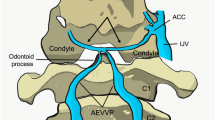Abstract
Purpose
Although neuroradiologists and skull base neurosurgeons are aware of the existence of veins within the clivus, such vessels have seldom been described in the literature. The aim of the present study is to elucidate the detailed venous structure of the clivus.
Methods
Computed tomography digital subtraction venography (CT-DSV) images of 50 unruptured aneurysm cases were examined retrospectively.
Results
Eighteen emissary veins were identified in 14 (28.0%) cases. A half of the emissary veins connected the inferior petrosal sinus with the inferior petro-occipital vein (IPOV) in the middle clivus. The clival diploic vein (CDV) was identified in 14.0% of cases, 42.9% of which had the clivus of the presellar type. The CDV was connected to the posterior intercavernous sinus or the rostral end of the basilar plexus superiorly, and was connected to the IPOV, anterior condylar vein, marginal sinus, or the anterior condylar confluence.
Conclusion
The CDV provides collateral channels between the cavernous sinus and the internal jugular vein and the inferior petrosal sinus and the IPOV. Understanding of the emissary veins in the clivus and the CDV is valuable for skull base surgery, especially for endonasal endoscopic skull base procedures.



Similar content being viewed by others
References
Esposito F, Becker DP, Villablanca JP, Kelly DF (2005) Endonasal transsphenoidal transclival removal of prepontine epidermoid tumors: technical note. Neurosurgery 56:E443. doi:10.1227/01.NEU.0000157023.12468.6A
Fraser JF, Nyquist GG, Moore N, Anand VK, Schwartz TH (2010) Endoscopic endonasal minimal access approach to the clivus: case series and technical nuances. Neurosurgery 67:150–158. doi:10.1227/01.NEU.0000383130.80179.41
Fraser JF, Nyquist GG, Moore N, Anand VK, Schwartz TH (2010) Endoscopic endonasal transclival resection of chordomas: operative technique, clinical outcome, and review of the literature. J Neurosurg 112:1061–1069. doi:10.3171/2009.7.JNS081504
Kassam A, Snyderman CH, Mintz A, Gardner P, Carrau RL (2005) Expanded endonasal approach: the rostrocaudal axis. Part II. Posterior clinoids to the foramen magnum. Neurosurg Focus 19:E4
Stippler M, Gardner PA, Snyderman CH, Carrau RL, Prevedello DM, Kassam AB (2009) Endoscopic endonasal approach for clival chordomas. Neurosurgery 64:268–277. doi:10.1227/01.NEU.0000338071.01241.E2
Mortazavi MM, Shane Tubbs R, Riech S et al (2012) Anatomy and pathology of the cranial emissary veins: a review with surgical implications. Neurosurgery 70:1312–1318. doi:10.1227/NEU.0b013e31824388f8
Mizutani K, Toda M, Yoshida K (2015) Analysis of the intercavernous sinuses using multidetector computed tomography digital subtraction venography (CT-DSV). Clin Neurol Neurosurg 131:31–34. doi:10.1016/j.clineuro.2015.01.021
Shibao S, Toda M, Orii M, Fujiwara H, Yoshida K (2016) Various patterns of the middle cerebral vein and preservation of venous drainage during the anterior transpetrosal approach. J Neurosurg 124:432–439. doi:10.3171/2015.1.JNS141854
Hamberger CA, Hammer G, Norlen G, Sjogren B (1961) Transantrosphenoidal hypophysectomy. Arch Otolaryngol 74:2–8. doi:10.1001/archotol.1961.00740030005002
Funaki T, Matsushima T, Peris-Celda M, Valentine RJ, Joo W, Rhoton AL Jr (2013) Focal transnasal approach to the upper, middle, and lower clivus. Neurosurgery 73:155–190. doi:10.1227/01.neu.0000431469.82215.93
Tubbs RS, Watanabe K, Loukas M, Cohen-Gadol AA (2014) Anatomy of the inferior petro-occipital vein and its relation to the base of the skull: application to surgical and endovascular procedures of the skull base. Clin Anat 27:698–701. doi:10.1002/ca.22268
Jung C, Kwon BJ, Kwon OK et al (2009) Intraosseous cranial dural arteriovenous fistula treated with transvenous embolization. Am J Neuroradiol 30:1173–1177. doi:10.3174/ajnr.A1528
Schnitzlein HN, Murtagh FR, Arrington JA, Parkinson D (1985) The sinus of the dorsum sellae. Anat Rec 213:587–589. doi:10.1002/ar.1092130415
García-González U, Cavalcanti DD, Agrawal A et al (2009) The diploic venous system: surgical anatomy and neurosurgical implications. Neurosurg Focus 27:E2. doi:10.3171/2009.8.FOCUS09169
San Millán Ruíz D, Gailloud P, Rüfenacht DA, Delavelle J, Henry F, Fasel JH (2002) The craniocervical venous system in relation to cerebral venous drainage. AJNR Am J Neuroradiol 23:1500–1508
Scheuer L, Black S (2000) CHAPTER FIVE—head and neck. In: Developmental Juvenile Osteology. Academic Press, London, pp 36–170
O’Rahilly R, Müller F (1986) The meninges in human development. J Neuropathol Exp Neurol 45:588–608
Hofmann E, Prescher A (2012) The clivus: anatomy, normal variants and imaging pathology. Clin Neuroradiol 22:123–139. doi:10.1007/s00062-011-0083-4
Padget DH (1956) The cranial venous system in man in reference to development, adult configuration, and relation to the arteries. Am J Anat 98:307–355. doi:10.1002/aja.1000980302
Padget DH (1957) The development of the cranial venous system in man from the viewpoint of comparative anatomy. Contrib Embryol 36:79–140
Kurata A, Suzuki S, Iwamoto K et al (2012) A new transvenous approach to the carotid-cavernous sinus via the inferior petrooccipital vein. J Neurosurg 116:581–587. doi:10.3171/2011.4.JNS102155
Acknowledgments
The authors thank Dr. Masaki Komiyama and Dr. Hiro Kiyosue for their advice on neurovascular anatomy and embryology.
Author information
Authors and Affiliations
Corresponding author
Ethics declarations
We declare that all human and animal studies have been approved by the ethics committee of Keio University School of Medicine and have therefore been performed in accordance with the ethical standards laid down in the 1964 Declaration of Helsinki and its later amendments. We declare that all patients gave informed consent prior to inclusion in this study.
Conflict of interest
We declare that we have no conflict of interest.
Rights and permissions
About this article
Cite this article
Mizutani, K., Toda, M., Kurasawa, J. et al. Analysis of the venous channel within the clivus using multidetector computed tomography digital subtraction venography. Neuroradiology 59, 213–219 (2017). https://doi.org/10.1007/s00234-017-1784-4
Received:
Accepted:
Published:
Issue Date:
DOI: https://doi.org/10.1007/s00234-017-1784-4




